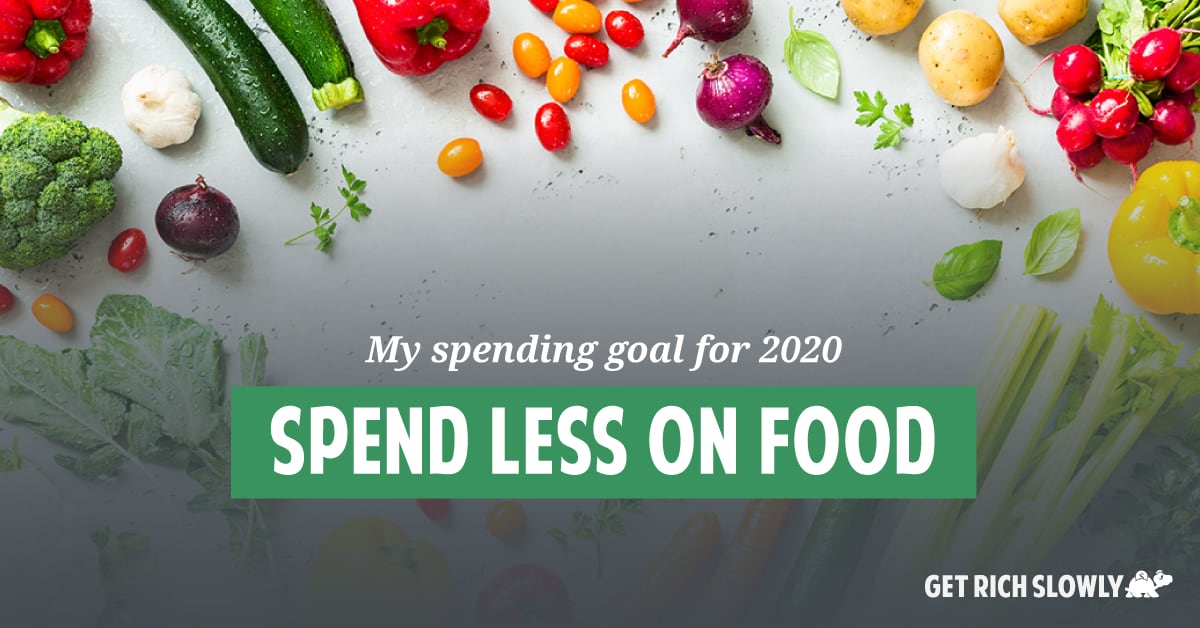My spending goal for 2020: Spend less on food

I'm pleased to report that 2020 is off to a fine start. As I mentioned in my year-end review, 2019 sucked for me. I have high hopes that this year will be a vast improvement. So far, it has been.
The biggest change is that I'm not drinking alcohol. While this is meant as a January-only test, it's possible that I'll extend the experiment. It's saving me money and making me more productive. Plus, it may be helping with my anxiety and depression. I like that. (Thanks to the GRS readers who sent me private notes about their own struggles with alcohol. I appreciate it.)
I've made other small changes this year too. While I didn't make any resolutions — I rarely do — I'm using the new year as a prompt to alter some of my habits, to do things differently.
One area that both Kim and I want to focus on in 2020 is our food spending. In 2018, I spent an average of $1038.03 per month on food. While I don't have complete numbers for 2019 (my expense tracking was messy in the latter half of the year), I know that while my food spending declined, it didn't decline by much. I want to change that.
To that end, Kim and I are making a couple of changes. For one, I'm canceling HelloFresh…at least for now. Plus, there's the whole “cut out alcohol” thing. While alcohol isn't included in my food spending, it contributes to my food spending. It leads us to eat out more. We want to reduce our restaurant spending in 2020.
Let's take a closer look at how I hope to spend less on food this year.
Good-bye, HelloFresh
Last year was the year I experimented with HelloFresh, the meal delivery service. Mostly, I like it. Mostly. I like the HelloFresh recipes. I like the convenience. I like the company itself.
That said, there are enough downsides to HelloFresh that starting next week, I'm dropping the service. Part of this is because of me. Part of this is because of HelloFresh itself.
On the me side, I need to walk more. I need to get more exercise, and I need to experience my neighborhood. As part of that, I want to make regular trips to the grocery store — by foot.
Also on the me side, I like greater variety than HelloFresh offers. It's not that HelloFresh doesn't offer different meals and cuisines — because it does. But the recipes themselves have a relentless sameness about them. Yes, you can choose Italian or Korean or American dishes, but the preparation is always always always the same. It's boring.
Those are the problems with me. There are also problems with HelloFresh itself.
For instance, I'm sick of the never-ending push to get me to promote the service to my friends. Get lost. Every week, the HelloFresh package contains a plea to share sign-up codes with friends. Every week when I choose my meals online, there's an additional plea to share sign-up codes with friends. Every week in the follow up e-mails, there's a plea to share sign-up codes with friends. I'm over it.
But the biggest strike against the service is its inability to get produce right.
Most weeks, there's at least one meal with a shitty piece of produce. It's usually (but not always) a tomato. One meal I prepped last week had a rotten lemon. (I've never even seen a rotten lemon before!) It's as if there's no quality control.
And at least once per month, a vegetable is simply missing. Absent. Not in the bag. During Thanksgiving week, for instance, I was prepping a meal with asparagus almandine, which sounded awesome. But the package I received contained no asparagus. I scrambled to find a substitute — Brussels sprouts — but it was a poor replacement.
The Cost of Convenience
Plus, there's the cost. When we first tried HelloFresh in June 2018, I crunched the numbers. Meals from HelloFresh cost about $10 per person. If I were to purchase the ingredients myself, the cost was just over $3 per person. At three meals per person per week, I've been paying an extra $175 per month for groceries that I don't need to pay.
When I signed up for HelloFresh, I did so because I hoped it would save me money. I hoped that it would keep me out of the grocery store (which it does, actually) and that in turn would reduce my grocery spending. I tend to make a lot of impulse purchases at the supermarket, so this seemed like sound reasoning.
The results of this experiment were inconclusive. For the first half of 2019, my home food spending (HelloFresh and groceries combined) dropped from $620.92 per month to $553.45 per month. But during the last two months of the year, I spent $729.38 per month. Was that year-end spike because of the holidays? The huge Costco trip I made in early November? I don't know. Maybe I should dive deeper.
In any event, if I did save money, it isn't nearly as much as I'd hoped I would save.
That said, Kim and I have really enjoyed many of the meals we've ordered from HelloFresh. And we're especially keen on the recipe cards. They're a lot of fun. They make cooking simple — even if they are relentlessly the same.
Because I'm a nerd, I've saved every recipe card from every HelloFresh meal we've ordered. And to get nerdier yet, I've both graded each recipe and taken notes on it. In other words, we have a customized illustrated “cookbook” containing over 100 different recipes. (Plus, all 2500+ of the HelloFresh recipes are available for free from their website.)
Going forward, I intend to use these recipe cards to plan and prep our meals. Instead of ordering from HelloFresh itself, though, I'm going to walk to the grocery store (carrying my backpack) to buy the ingredients. This should prevent me from buying crap we don't need while allowing me to obtain better produce than HelloFresh tends to send.
We'll see how it works.
Here's another way Kim and I have come up with to cut costs on food: batch cooking. It's nothing new, I know, but it's new to us. We won't do once-a-month cooking, but we'll each pick one recipe per week and make a larger version of it.
I'll pick one HelloFresh cards and make three nights of the meal, for example. Last Sunday, Kim prepped a big batch of pork tacos that we've eaten for dinner the past three nights. And so on. We think this'll keep life simple and keep me out of the grocery store.
Rascally Restaurants
Kim and I will also try to cut back on food spending this year by reducing how much we dine out. Left to our own devices, we choose restaurants much of the time. That gets expensive.
- In 2017, I spent an average of $567.97 per month on restaurants. Kim spent some unknown amount too (but much less).
- In 2018, I spent an average of $389.63 per month on restaurants. Plus, Kim spent some. So, we made big gains in 2018, but our spending was still high.
- As I mentioned, my records are incomplete for last year, but I know I spent $288.04 for restaurants during the last two months of 2019.
From 2017 to 2019, we cut our restaurant spending in half. That's great progress! Still, there's room for improvement.
I spent an average of $66.47 per week on restaurants last year. My gut feeling is that this is basically dining out once per week. I know from experience that our typical check is about $55, which includes our two meals plus two beers each. After tip, that's $66. That's our standard meal. (And it's usually on a Thursday night.)
So far in 2020, we've had one restaurant meal and it cost us exactly $34 (including tip). If we'd both had our typical two beers, that check would have been about $58. By not drinking, we saved ourselves more than twenty bucks!
Kim and I do enjoy eating out together, so it's not something we want to eliminate. Instead, we want to be more mindful about how and where we dine out when we do dine out.
We've already shifted our focus from fancier places (which is where we were eating in 2017) to cheap and tasty spots. But now we're interested in finding places that are even less expensive. And, at least for now, we want to be careful to avoid spots that might tempt us to drink. (Our favorite pub has great food and a cozy environment, but we both know it's madness for us to eat there. It'll make us want to drink beer.)
It's far to early to predict how this whole restaurant thing is going to go in 2020. But we've thought of a couple of ways to cut costs (in addition to the “not drinking” thing.) As I said, we can turn our attention to less expensive eateries. Why go to the fancy Mexican place with “gourmet” tacos that cost $8 or $9 when we can go to the cheap place down the hill with $4 tacos? Let's try that new ramen spot.
Plus, we might try take-out this year. Neither one of us has ever been a big proponent of ordering food to go, but I think it makes some sense right now. On my way home from the new office, I can pick up something tasty for dinner from the Thai place or the Italian place, maybe. We can have the restaurant food without restaurant temptation.
The Last Big Win
Food seems to be the last major place that I can trim my budget. My austerity measures in 2019 yielded excellent results, and I'll continue to pursue those in the future. But I've cut most of my discretionary spending as far as I want to cut it at present. Food is the exception.
- I averaged spending $1176.06 per month on food in 2017.
- That dropped to $1038.03 in 2018.
- During the last two months of 2019, I spent an average of $1053.28 per month on food.
As I say, we're making progress, but I feel there's more to be had here. This is the last big win left in my budget. It'd be great if I could trim my food spending to, say, $800 per month (or lower!) in 2020. That'd be a fantastic drop from $1200 each month in 2017, right? I'd call that a victory.
On a food-related note, I should point out that eliminating (or reducing) alcohol could also save me plenty of money. During the past three years, I've reliably spent about $250 per month on alcohol — and that doesn't include alcohol in restaurants. Going dry could help my health and wealth.
Become A Money Boss And Join 15,000 Others
Subscribe to the GRS Insider (FREE) and we’ll give you a copy of the Money Boss Manifesto (also FREE)

